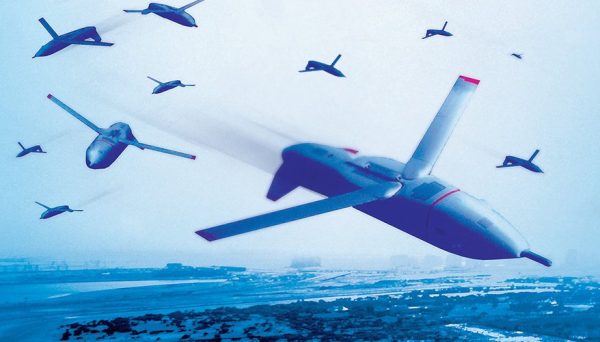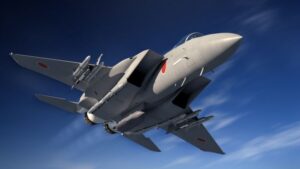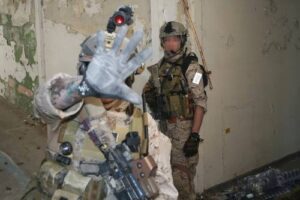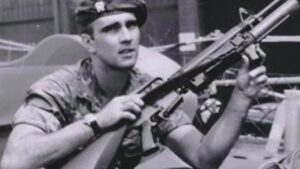The following article first appeared on Warrior Maven, a Military Content Group website.
Blanketing enemy areas with surveillance, testing or “jamming” enemy air defenses, patrolling coastal areas from the surface along the perimeter of enemy territory, launching drone swarm attacks to overwhelm enemy defenses, and even destroying enemy drones … are merely a few of the possible missions expected from the Pentagon’s evolving “Replicator” unmanned systems effort.
In development for several years, the “Replicator” effort involves groups of drones, operating in coordination with varying levels of autonomy and AI-enabled computing across multiple domains; Replicator in recent months has entered an accelerated phase in its development, according to Deputy Secretary of Defense Kathleen Hicks.
“I am pleased to announce that the Department will begin investing in scalable production for these critical capabilities,” Hicks said earlier this year, according to a Pentagon transcript of her remarks.
The initial manufacturing, Hicks explained, is designed to expedite several key needed concepts of operation to include destroying enemy drones, operating on the surface of the ocean and simply flying in the air from various host platforms.
“The first tranche of Replicator capabilities include uncrewed surface vehicles (USV), uncrewed aerial systems (UAS) and counter-uncrewed aerial systems (c-UAS) of various sizes and payloads from several traditional and non-traditional vendors,” the Pentagon statement said.
The following article first appeared on Warrior Maven, a Military Content Group website.
Blanketing enemy areas with surveillance, testing or “jamming” enemy air defenses, patrolling coastal areas from the surface along the perimeter of enemy territory, launching drone swarm attacks to overwhelm enemy defenses, and even destroying enemy drones … are merely a few of the possible missions expected from the Pentagon’s evolving “Replicator” unmanned systems effort.
In development for several years, the “Replicator” effort involves groups of drones, operating in coordination with varying levels of autonomy and AI-enabled computing across multiple domains; Replicator in recent months has entered an accelerated phase in its development, according to Deputy Secretary of Defense Kathleen Hicks.
“I am pleased to announce that the Department will begin investing in scalable production for these critical capabilities,” Hicks said earlier this year, according to a Pentagon transcript of her remarks.
The initial manufacturing, Hicks explained, is designed to expedite several key needed concepts of operation to include destroying enemy drones, operating on the surface of the ocean and simply flying in the air from various host platforms.
“The first tranche of Replicator capabilities include uncrewed surface vehicles (USV), uncrewed aerial systems (UAS) and counter-uncrewed aerial systems (c-UAS) of various sizes and payloads from several traditional and non-traditional vendors,” the Pentagon statement said.
Overall, the tactical elements of Replicator are described by Pentagon weapons developers in terms of “All-Domain-Attributeable-Autonomy,” (ADA2), a concept advancing the operational use of low-cost, yet networked and coordinated groups of unmanned systems conducting missions across multiple domains in a seamless, high-speed fashion. One of the key elements of an “attritable” drone force likely involve efforts to build in operational resilience by engineering small, lower-cost drones which can be lost with little negative impact. Simple redundancy is part of this equation as well, given that a large number of drones or ISR “nodes” or weapons can simultaneously provide multiple sources of data and ensure continued mission functionality in the event some drones are destroyed or disabled. A given enemy area, for example, can be blanketed at one time with multiple nodes using different surveillance vectors, and enemy targets can be tracked, descended upon and destroyed with multiple strikes from different angles. Yet another beneficial element of a redundancy strategy can simply be described in terms of the Pentagon’s use of the word “attributable.” This means that a mission can continue effectively in the event that some nodes within a group or swarm are destroyed or disabled by enemy attacks.
A Pentagon essay explained that a second tranche was on the way and that. The first tranche of Replicator also certain capabilities that remain classified, including others in the maritime domain and some in the counter-UAS portfolio.
Replicator Operations
The operational scope of Replicator likely has origins in several key developmental programs across the military services, such as the US Navy’s Ghost Fleet Operation Overlord initiative. Beginning as an Office of Naval Research project, the Ghost Fleet program has steadily evolved in recent years to a point wherein large groups of USVs, aerial drones and larger unmanned platforms can increasingly operate autonomously in coordination with one another. Advanced algorithms now enable groups of surface and air drones to gather, process and transmit key mission-critical data – and make some adjustments – without needing human intervention. Targeting details, enemy movements and tactical adjustments can be made autonomously across a group of nodes at one time, using high-speed computing, high-resolution sensing and advanced, AI-enabled algorithms. Certainly lethal force will still be decided by a “human” in the loop, yet this tactical concept involving “coordinated” groups of unmanned systems massively improves and expedites operational options for wartime commanders.
Most of Ghost Fleet’s progress involves small-to-medium sized surface and air drones such as the Unmanned Surface Vessels able to search for mines and submarines, surveil high-risk areas or even launch attacks … Yet in more recent years the effort has become more multidomain and greatly expanded to coordinate with nodes able to travel undersea and large surface drones such as the Navy’s Medium and Large Unmanned Surface Vehicles. Now, with Replicator, swarms of mini-drones can operate across domains in coordination with one another. Swarming behavior is something the Pentagon has been working on for quite some time, as DoD Scientists began studying natural swarming behavior of birds to help develop algorithms for drones. The practice, explained by top Pentagon researchers as “Biomemetics” worked to develop computer algorithms based to some extent upon biological phenomena.
For the air portion of Replicator, Hicks indicated that the Pentagon will accelerate fielding of the Switchblade-600 loitering munition, produced by Simi Valley, CA-based AeroVironment Inc. U.S.-supplied Switchblade drones have already demonstrated great lethality and utility in Ukraine, and the systems guidance systems and loitering abilities have been upgraded to provide additional capability to U.S. forces.
It seems clear that the multi-domain elements of the emerging Replicator program are generating great interest from US Combatant Commanders in the Pacific.
“This is a critical step in delivering the capabilities we need, at the scale and speed we need, to continue securing a free and open Indo-Pacific” said Admiral Samuel Paparo, commander of U.S. Indo-Pacific Command. “The entire Department has come together to help make this a reality.”
Hicks also focused on the production of Replicator systems, explaining that the integration between commercial technologies, large defense primes and small innovators is driving new abilities to fast-track critically needed technologies to war.



